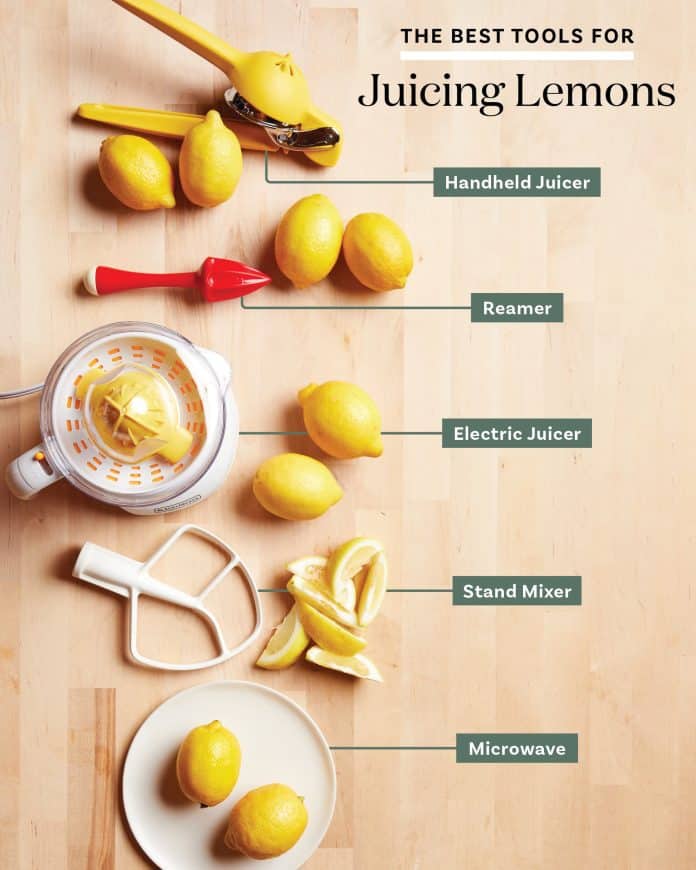Lemon juice adds a tangy zest to our favorite recipes, but when it comes to cleaning our trusty lemon juicer, we often find ourselves feeling a little puzzled. Worry not, as we have the perfect solution to give your lemon juicer a sparkling clean makeover. In this article, we will share some simple yet effective tips on how to effortlessly clean your lemon juicer, ensuring it stays in great shape and ready for your next citrusy adventure.
Review contents
Gather necessary materials
Cleaning a lemon juicer is a relatively simple task, but it requires a few basic materials to ensure that you effectively remove all residue and keep your juicer in optimal condition. Here’s a list of what you’ll need:
Dish soap
Using a mild dish soap is essential for breaking down grease and removing any sticky residue left behind by the lemon juice. Look for a gentle dish soap that is safe for use on kitchen utensils.
Soft brush or sponge
To scrub away any dirt, stains, or residue, you’ll need a soft brush or sponge. Avoid using abrasive materials that could scratch or damage the surface of your juicer.
Warm water
Warm water is perfect for rinsing off the juicer and removing any loose pulp or juice remnants. Make sure the water is not too hot, as this could cause some parts to warp or become damaged.
Baking soda
For stubborn stains or odors, baking soda is a natural and effective cleaning agent. It helps to break down stubborn stains and removes any unpleasant smells that may linger inside the juicer.
White vinegar
White vinegar is excellent for removing mineral deposits and scale that can accumulate over time. It’s particularly useful if you live in an area with hard water, as it helps dissolve the deposits and leaves your juicer sparkling clean.
Microfiber cloth or towel
A microfiber cloth or towel is perfect for drying your juicer without leaving behind lint or scratches. It absorbs moisture quickly and leaves a streak-free finish, ensuring that your juicer looks its best.
Toothpicks
Toothpicks are handy for removing pulp that gets stuck in small crevices, especially in the strainer or filter. They help to dislodge any residue that may be difficult to reach with a brush or sponge.
Rubber gloves
Wearing rubber gloves while cleaning your juicer is a great idea to protect your hands from any chemicals or hot water. It also gives you a better grip when handling slippery parts.
Disassemble the juicer
Before you start cleaning your lemon juicer, it’s important to disassemble it properly. Disassembling the juicer allows you to clean each part thoroughly and ensures that no area is overlooked. Follow these steps to disassemble your juicer:
Remove any detachable parts
Check your juicer for any detachable parts like the pulp collector, juice container, or any other components that can be easily removed. Take them out and set them aside for cleaning.
Separate the strainer or filter
The strainer or filter is typically one of the most critical parts of a lemon juicer, as it catches all the pulp and seeds. Separate it from the juicer and place it aside for a more detailed cleaning.
Take out any pulp collector or container
If your juicer has a pulp collector or container, remove it carefully and empty any leftover pulp or seeds into the compost or trash bin. This will prevent any decaying organic matter from causing unpleasant smells or attracting pests.
Check the user manual for specific instructions
To ensure that you disassemble your juicer correctly, it’s always a good idea to consult the user manual that came with your juicer. The manufacturer’s instructions may provide additional details or specific steps for your particular model.
This image is property of cdn.apartmenttherapy.info.
Rinse the juicer
Now that your juicer is disassembled, it’s time to rinse off any leftover pulp or juice. This step helps remove loose debris and prepares your juicer for a more thorough cleaning. Here’s how to rinse your juicer effectively:
Use warm water to rinse off any leftover pulp or juice
Place each disassembled part of your juicer under warm running water. This will help to wash away any remaining pulp or juice that may be clinging to the surface or lodged in small crevices.
Gently shake the juicer to remove excess water
After rinsing each part, give them a gentle shake to remove any excess water. It’s important to ensure that water doesn’t pool or remain trapped in any of the parts, as this could lead to mold or bacterial growth.
Hand wash the juicer
Once you’ve rinsed off the juicer, it’s time to give it a thorough hand wash with warm soapy water. This step helps to remove any remaining residue or stains and leaves your juicer looking clean and fresh. Follow these steps for a proper hand wash:
Start by filling your sink or a basin with warm water
Fill your sink or a basin with enough warm water to comfortably submerge the juicer parts. The water should be warm but not too hot to touch.
Add a few drops of dish soap to create a soapy solution
Add a few drops of dish soap to the water and mix it well to create a soapy solution. Make sure to use a gentle dish soap that is safe for use on kitchen utensils.
Place the juicer parts in the soapy water
Submerge each disassembled part of your juicer into the soapy water. Leave them to soak for a few minutes to loosen any residue or stains that may be stuck on the surface.
Scrub the parts with a soft brush or sponge
Take a soft brush or sponge and gently scrub the juicer parts, paying extra attention to areas with visible residue or stains. Use circular motions and apply slight pressure to remove any dirt or grime.
Focus on areas with residue or stains
Areas that come into contact with lemon juice, such as the strainer or filter, might have more stubborn residue or stains. Concentrate your efforts on these areas to ensure they are thoroughly cleaned.
Clean the strainer or filter thoroughly
The strainer or filter is responsible for collecting the pulp and seeds while allowing the juice to flow through. Use a brush or sponge to clean it carefully, making sure to remove any pulp or debris that may be trapped.
Use toothpicks to remove pulp stuck in small crevices
Toothpicks are excellent tools for dislodging any pulp or residue that is hard to reach with a brush or sponge. Gently insert the toothpick into small crevices and move it around until the debris comes loose.
Rinse the parts with warm water
Once you’ve finished scrubbing all the parts, rinse them thoroughly under warm running water. This will remove any remaining soap residue and ensure that your juicer is clean and ready to use.
Check for any remaining dirt or stains
After rinsing, examine each part closely to check for any remaining dirt, stains, or residue. If you notice any, repeat the cleaning process for those specific areas until they are completely clean.
Repeat the cleaning process if necessary
If you find that some parts are still not entirely clean after the initial wash, don’t hesitate to repeat the cleaning process. Stubborn stains may require a little extra effort and attention to ensure their complete removal.
This image is property of hips.hearstapps.com.
Remove stains or mineral deposits
Over time, lemon juice and mineral deposits can cause stains or build-up in your juicer. To keep your juicer looking pristine, it’s essential to know how to remove these stains or deposits effectively. Here are some steps to follow:
Create a paste using baking soda and water
Mix a spoonful of baking soda with enough water to form a paste. Baking soda is a natural and gentle abrasive that helps break down stains without damaging the surface of your juicer.
Apply the paste to the stained areas
Using a soft brush or sponge, apply the baking soda paste to any stained areas on your juicer. Focus on the spots that require extra attention, such as discoloration from citrus fruit or stubborn stains from prolonged use.
Let it sit for a few minutes
Allow the baking soda paste to sit on the stained areas for a few minutes. This will give it time to penetrate the stains and help lift them off the surface.
Scrub gently with a soft brush or sponge
Using a soft brush or sponge, gently scrub the stained areas in circular motions. Apply slight pressure as needed, but be careful not to scrub too hard, as this could damage the surface of your juicer.
Rinse thoroughly with warm water
After scrubbing, rinse off the baking soda residue with warm water. Make sure to remove all traces of the paste and check if the stains have been successfully removed.
For mineral deposits, soak affected parts in white vinegar
If you have mineral deposits or limescale buildup on your juicer, soaking the affected parts in white vinegar can help dissolve and remove them. Fill a bowl or basin with enough white vinegar to completely submerge the parts.
Leave them for about 15 minutes
Place the affected parts in the white vinegar solution and let them soak for approximately 15 minutes. The vinegar’s acidity will help break down and dissolve the mineral deposits.
Scrub the deposits with a brush
After soaking, use a brush to scrub away the loosened mineral deposits. Be gentle but thorough, ensuring that you remove all traces of buildup.
Rinse with warm water
Once you’ve scrubbed away the mineral deposits, rinse the parts thoroughly under warm running water. This will remove any remaining vinegar and ensure that your juicer is clean and free from any residue.
Dry and reassemble the juicer
Properly drying your juicer is essential to prevent any moisture-related issues and ensure that it functions optimally. Once you’ve finished cleaning, follow these steps to dry and reassemble your juicer:
Pat the cleaned parts dry with a microfiber cloth or towel
Use a microfiber cloth or towel to gently pat each cleaned part dry. Microfiber material is excellent for absorbing moisture without leaving behind lint or scratches.
Allow them to air dry completely
After patting dry, place the juicer parts in a well-ventilated area to air dry completely. This helps ensure that any hidden moisture evaporates, preventing mold or mildew from forming.
Ensure there is no moisture left
Before reassembling the juicer, double-check that there is no moisture or water droplets remaining on any of the parts. Any moisture left behind could affect the juicer’s performance or lead to bacterial growth.
Reassemble the juicer according to the user manual
Refer to the user manual that came with your juicer to guide you through the reassembly process. Follow the provided instructions to ensure that you put your juicer back together correctly.
Make sure all parts are properly aligned
As you reassemble the juicer, ensure that all parts are aligned correctly. Proper alignment is crucial for the juicer to function effectively and prevent any leaks or malfunctions.
Securely tighten any screws or locking mechanisms
If your juicer has any screws or locking mechanisms, make sure to tighten them securely. Loose parts can cause instability or compromised performance, so it’s important to ensure everything is properly secured.
This image is property of i.ytimg.com.
Clean the exterior of the juicer
While it’s essential to focus on cleaning the interior parts of your juicer, don’t forget about its exterior. A clean and shiny exterior adds to the overall appeal of your juicer. Here’s how to clean the exterior effectively:
Wipe the exterior using a damp cloth
Start by wiping the exterior surfaces of your juicer with a damp cloth. Make sure the cloth is not dripping wet, as excessive water on the exterior can seep into the motor or control buttons.
For stubborn stains, use a mild cleaning solution
If there are any stubborn stains or dried-on residue on the exterior, you can use a mild cleaning solution. Create a mixture of warm water and dish soap and apply it to a soft cloth or sponge. Gently scrub the stained areas, taking care not to scrub too hard.
Avoid harsh chemicals or abrasive materials
To protect the exterior surfaces of your juicer, avoid using harsh chemicals or abrasive materials. These can cause damage or scratches to the finish, diminishing the overall appearance.
Dry the exterior with a clean cloth
After cleaning, use a clean, dry cloth to thoroughly dry the exterior of your juicer. This will remove any remaining moisture and prevent water spots from forming on the surface.
Maintain regular cleaning
To keep your lemon juicer in top-notch condition, maintaining a regular cleaning routine is essential. Regular cleaning prevents residue and stains from building up and ensures that your juicer operates smoothly. Follow these tips for effective maintenance:
Clean the juicer immediately after each use
Cleaning your juicer immediately after each use prevents residual pulp or juice from drying and sticking to the surfaces. It makes the cleaning process much easier and saves you time and effort in the long run.
Prevent residue from drying on the juicer
If you’re unable to clean your juicer right away, at least rinse off the parts and soak them in warm, soapy water. This prevents sticky residue from drying and becoming more difficult to remove.
Follow the manufacturer’s instructions
Always refer to the manufacturer’s instructions for specific cleaning guidelines for your juicer. Different models and brands may have unique cleaning requirements, so it’s important to follow their recommendations.
Regularly check for any signs of wear or damage
During the cleaning process, take the opportunity to inspect your juicer for any signs of wear or damage. Check for loose parts, cracks, or any other issues that may affect its performance or safety.
Replace any worn-out or broken parts
If you notice any worn-out or broken parts during your inspection, it’s crucial to replace them promptly. Using a faulty juicer can compromise its effectiveness and potentially put your safety at risk.
This image is property of Amazon.com.
Deep cleaning and descaling
Periodic deep cleaning and descaling ensure that your lemon juicer remains in excellent condition and operates optimally for years to come. Here’s what you need to know about deep cleaning and descaling:
If required, perform periodic deep cleaning
Depending on your usage and the specific requirements of your juicer, you may need to perform a deep cleaning every few months or as recommended by the manufacturer. Deep cleaning involves a more thorough and intensive cleaning process.
Use specialized descaler products if recommended by the manufacturer
Some juicers may require the use of specialized descaling products to remove mineral deposits or limescale buildup effectively. These descaler products are designed specifically for juicers and help maintain their performance.
Follow the provided instructions for descaling
When using a descaling product, carefully follow the instructions provided by the manufacturer. The instructions will guide you on how much descaling solution to use, how long to let it sit, and how to rinse it off thoroughly.
Always rinse thoroughly after descaling
It’s crucial to rinse off any descaling solution thoroughly after the recommended contact time. Residue from the descaling product left on your juicer can affect the taste of your juice or potentially harm your health.
Clean all parts carefully
During a deep cleaning session, make sure to clean all parts of your juicer meticulously. Pay attention to those areas that are often overlooked during regular cleaning, such as the motor housing or any ventilation openings.
Tips for effective cleaning
Cleaning your lemon juicer doesn’t have to be a daunting task. With these tips, you can ensure that your cleaning process is effective, efficient, and easy:
Wear rubber gloves to protect your hands
Protect your hands from the detergent or hot water by wearing rubber gloves. This will also give you a better grip when handling slippery parts.
Avoid using abrasive materials that can damage the juicer
To prevent scratches or damage to your juicer, avoid using abrasive materials like steel wool or harsh scrub brushes. Stick to soft brushes, sponges, or non-abrasive cleaning tools.
Clean the juicer on a stable and clean surface
When cleaning your juicer, make sure to place it on a stable and clean surface. This will prevent any accidental spills or damage to your juicer while you work.
Pay extra attention to areas with small crevices
Small crevices are often where residue and debris can accumulate, so make sure to pay extra attention to these areas during the cleaning process. Use toothpicks or small brushes to reach these hard-to-clean spots.
Never submerge the entire juicer in water
While it’s important to clean all the detachable parts of your juicer, never submerge the entire juicer in water. This can damage the electrical components and compromise the juicer’s functionality.
Regularly clean and maintain the juicer for optimal performance
Regular cleaning and maintenance are key to ensuring that your lemon juicer continues to perform at its best. By keeping your juicer clean, you not only prolong its lifespan but also enjoy fresh and delicious juice every time you use it.
In conclusion, maintaining a clean and well-maintained lemon juicer not only ensures optimal performance but also extends its lifespan. By following the steps outlined in this article and implementing the tips provided, you can keep your juicer looking and functioning like new. Regular cleaning, rinsing, and drying are essential after each use, with periodic deep cleaning and descaling to remove stubborn stains and mineral deposits. Remember to consult your juicer’s user manual for specific instructions and recommendations from the manufacturer. With a little time and effort, your lemon juicer will continue to provide you with refreshing and delicious citrus juices for years to come.
This image is property of Amazon.com.





































